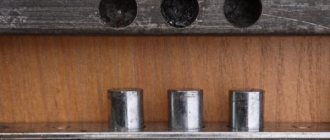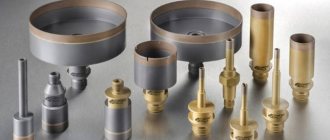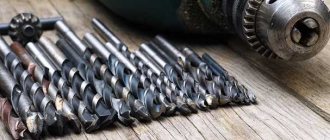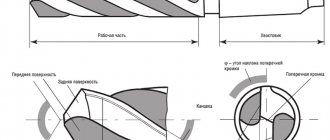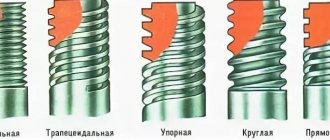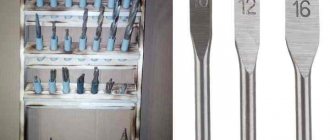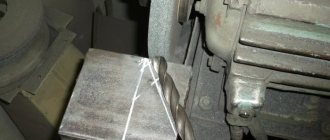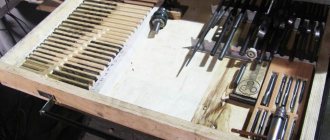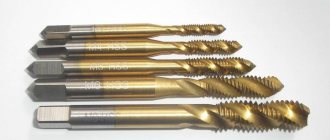A diamond drill is a type of reliable and durable cutting tool used for drilling, reaming and making holes in brittle and high-strength materials. The working part of the product consists of diamond grains of varying degrees of granularity, fixed with a binder to the body. Manufacturers from different countries produce diamond drills that differ in area of use, manufacturing technology and design. Construction, machine- and instrument-making industry, radio electronics, agriculture – this is not a complete list of industries where it is impossible to do without their use, not to mention household work. This tool is suitable for ferrous and non-ferrous metals, porcelain stoneware, stone, ceramic tiles, brick, concrete and other metallic and non-metallic materials in which it is difficult to drill holes or even impossible to do this with the help of other cutting tools.
Types of Diamond Drills
The tool is classified according to the following criteria:
- manufacturing method;
- the shape of the working part;
- the material with which he can work;
- diameter;
- designs;
- cutting method.
Electroplating and sintering are the main methods for making diamond drill bits. The first method, i.e., spraying, produces products with a cutting part of a conical type and a tubular shape of a complex configuration of any diameter. Their resistance to wear is lower than that of cutting tools made by sintering. In the second method, the product is manufactured using powder metallurgy, which has one drawback - the impossibility of manufacturing small-diameter tools due to the technological complexity of the process.
The shape of the working surface can be of the following types:
- spear-shaped or feather-shaped;
- conical;
- spherical;
- cylindrical.
A product with a cylindrical working part can be tubular or ring-shaped. The tubular diamond drill has a cylindrical body made of high-quality steel (high-speed, carbon, high-alloy), and its end is sprayed with powder of different fractions. Such instruments with glass and ceramics work with cooling: a special liquid (coolant) or water is supplied to the working part.
Diamond core drill comes in different types. Diamond chips or powder can be applied in a continuous layer to a certain height or on segments located along the circumference with a certain pitch. There can be up to 14 of them. Drills of this type are produced with a diameter of 32 to 350 mm with a diamond layer height of up to 10 mm.
Manufacturers produce drills that can work with many materials (universal) or for a specific type. Diamond drills for metal, marble, glass, porcelain stoneware, etc. are available in the retail chain. Therefore, when selecting a product, you need to know what material it will work in, and you need to pay attention to this feature, as well as using what it will rotate and at what speed. For rotation, use a drill, screwdriver, electric screwdriver or machines that have an appropriately shaped chuck for securing them.
The rotation speed depends on the diameter of the drill used and the material in which the operation is performed. Approximate data is shown in the table.
| Diameter, mm | Rotation speed, rpm |
| 100÷350 | 200÷500 |
| 50÷100 | 500÷1200 |
| 25÷50 | 1200÷2500 |
| 15÷25 | 2000÷4500 |
| 8÷15 | 2500÷6000 |
| 3÷8 | 3000÷12000 |
| 1÷3 | 6000÷18000 |
Diamond drills for concrete - how to use correctly?
When carrying out renovations in premises, it is necessary to make holes for fastening objects in concrete or brick walls. Diamond concrete drills are used for this type of process.
Compared to metal drills, which quickly become dull, drilling with a diamond tool ensures a directed transfer of impact energy, maximizing the removal of slurry due to the spiral shape.
Characteristics of drills for concrete
A diamond-coated drill, or a diamond tubular drill, is a cylinder with 2 through passages on the sides to remove contaminants.
The main advantages of an electric drill include the equipment with strong alloys for soldering on top of the cutting element. The hardness of boron is as close as possible to the hardness characteristics of diamond. This alloy is called "win".
This type of drill is the most durable of all existing ones. Diamond bits are divided into 2 types:
- Designed for drills, available in polyhedron and cylinder shapes.
- Used for hammer drills with a cylindrical shank and marked SDS-plus, SDS-max.
There are products designed to work with a drill. More powerful products - crowns - are suitable for a hammer drill.
Features of use
When performing installation and using a drill, craftsmen obtain recesses ranging in size from 4 mm to 3 cm due to its versatility. Place the drill into the apparatus by pressing on the nozzle and pushing in the chuck, which is thickened at the end.
If the builder needs to achieve a recess in the wall up to 12 cm in diameter, they use another type of nozzle - a crown type. It is divided into subspecies: diamond and victorious.
The first one has a diamond coating, and the second one has small teeth made of pobedite.
If there is a need to drill passages for attaching sockets or switches, or a large number of wires, then use drills with a core drill. At the same time, it is imperative to know exactly the depth and diameter that you need to obtain in order to select the right tool. When choosing a suitable drill, they rely on the main feature - the larger the diameter needed, the longer the length.
Crowns are often used to create holes in a wall to accommodate an outlet.
How to use the device?
Electrochemical coating of one metal with another, which is more resistant to mechanical movement and chemical processes, allows you to select the appropriate drill diameter and type for different processes. You also need to make sure that the nozzle does not overheat. The cooling device should be stopped at regular intervals.
It is unacceptable to water the working parts with cold water. If, during drilling, an obstacle is discovered in the thickness of the concrete layer, you should change the drill used to cut metal. Having passed this section, insert the previous one again. For load-bearing walls it is better to use a hammer drill.
The power of this device will guarantee the required quality of the desired holes.
Features of use
The main thing when working with diamond drills is to prevent them from overheating. Therefore, it is recommended that when performing a drilling operation, perform it at minimum speed and periodically dip it in water. There are recommendations for using tools with one or another surface shape. For example, drilling holes in ceramics and glass must be done using a tool of tubular design. It is also necessary to carry out the drilling process correctly. It begins by setting the drill at a right angle. Work must be carried out without impact. It is recommended to use specially designed devices or jigs to facilitate the centering process.
What and how to drill tiles?
Repair at any stage raises a lot of difficulties and questions, especially when it comes to newcomers to this business. One of the most difficult materials to work with is tile. It is quite expensive, but at the same time extremely fragile. It is very important when working with tiles to do everything correctly the first time. The question often arises: what drill to use to drill tiles? Indeed, it is not difficult to get lost in the choice, because, at first glance, there are quite a lot of options. However, there are two really worthwhile options: an arrow-shaped drill and a diamond bit.
In order to make a miniature hole in tiles, you should choose an arrow-shaped drill. Using this drill, you can drill a hole in a wall that is already tiled. This way you can, for example, hang towel hooks in the bathroom or create fasteners on the kitchen wall.
Please note that with an arrow-shaped drill you can drill a hole not only in ceramic tiles, but also in porcelain tiles. A special drill for this material costs several times more, so you will save a lot. A standard arrowhead drill bit can drill up to five holes in porcelain tiles without grinding down.
Remember that when working with an arrow drill, it is important to use the drill only at low speed to minimize the possibility of damaging the tiles.
Let's look at all the benefits of a swept drill.
- This is one of the most effective options when it comes to drilling tiles.
- If you approach the use of this drill correctly, it will not become dull or damaged.
- Long service life is another important advantage of the arrow drill. Again, with proper use, such a drill will serve you for a very long time.
- Using a drill, you can make small holes with a diameter of up to 12 mm in the tile, which is very convenient for household use.
- And finally, the cost of the drill is also good news. With minimal financial costs, you will receive a high-quality tool for the job.
Diamond Tube Drill
A tube drill is a diamond-coated tube that allows you to create small diameter holes. Externally, such a drill resembles a diamond crown, but has a number of features. Firstly, to use a tubular drill you do not need a stationary machine; a standard drill or screwdriver will do. Secondly, you can use high rotation speed (when working with a diamond bit, it is recommended to work exclusively at low speed).
However, the main advantage lies in the so-called dry drilling. Most manufacturers place olive oil inside the drill, which performs a cooling function. If the manufacturer does not provide cooling material, then you will have to cool the nozzle with water during long-term operation.
If you are used to doing all the housework yourself, then purchasing a set of tubular drill bits for ceramics would be an excellent solution, as it includes options with different diameters. Of course, such a set is not cheap, but you will quickly understand that the expense was not in vain. High-quality drills do not wear out for a long time, do not require physical effort and are suitable for various types of work.
Diamond crown
A diamond bit, unlike an arrow drill, allows you to drill a hole with a large diameter in tiles. A conventional drill uses its entire plane when working, and a crown uses only the sharp cutting edge. As a result, the noise during operation is reduced, the amount of dust is reduced, the edges of the hole are perfectly even and smooth, and most importantly, the tile is not damaged.
In order for drilling with a diamond crown to give the desired effect, you must adhere to certain rules for working with it.
- Never use high drilling speed to avoid damaging the tiles. The optimal option when working with a diamond bit is considered to be a speed of 200-500 revolutions.
- It is best to use a crown in conjunction with a stationary machine.
- When working, do not forget about water cooling.
It is also quite difficult to choose the right diamond bit as there are different options. Firstly, you should start from the desired size of future holes. Construction stores offer crowns from 10 mm to 70 cm in diameter.
Secondly, it is advisable to buy a crown with a centering drill. The fact is that when working with ceramic tiles, it is quite difficult to use crowns without a centering drill, since they slide over the material.
In addition, there are diamond crowns for tiles and porcelain tiles. Outwardly, they are no different. In principle, for both materials you can use the first option of crowns, since it is significantly cheaper, but it is worth considering that when working with hard porcelain stoneware, such crowns will quickly become dull.
Useful tips
When the question of which drill to drill tiles with is resolved, all that remains is to familiarize yourself with a couple more secrets that will help you carry out the upcoming work as carefully as possible and not destroy the tiles.
- Carefully consider all locations for future holes. Take your time and use a building level, marking future holes with a marker. Don't expect to be able to do all the work by eye.
- Next, you need to make sure that the drill does not slip from the desired point. To do this, you can either seal the tile with transparent tape, or slightly scratch the enamel in the area of the future hole.
- Don't forget to turn off the hammer mode on your drill. Start working at minimum speeds. In the middle of the process, based on the situation, you can switch the drill to medium speed.
- During operation, the drill must be periodically cooled, and if necessary, also sharpened.
As soon as you reach the wall, immediately change the drill to a suitable one. Now you can continue working by turning on the shock mode and increasing the speed of revolutions.
proinstrumentinfo.ru
Popular manufacturers
When drilling, diamond drills from various Russian and foreign manufacturers are used to perform operations in popular materials used in construction, mechanical engineering, agriculture and at home. Particularly popular are products from BOSCH, CEDIMA, AEG (Germany), Hilti (Liechtenstein), SPLITSTONE, ZUBR (Russia), DI-STAR LLC (Ukraine), etc. All of them provide a long service life, high quality of the resulting surface and productivity.
We ask those who have worked with such cutting tools to share their experience in the comments to the text, and also talk about the nuances of using a drill, screwdriver, electric screwdriver or machine for these purposes.
How to choose?
To choose a drill for a power tool, you need to know exactly what type of electric drill is supported by a chuck - SDS-plus or SDS-max. The former are suitable for working with brick or medium-hard concrete. SDS-max shanks are adapted to interact with any hardness of concrete and brick. You can also choose a crown to create round holes. To guarantee quality, it is better to purchase drills from well-known companies.
In conclusion, it is worth noting that if the drill is broken or bent, you should absolutely not sharpen it yourself. Loading a rotary hammer with a crooked attachment can lead to tool breakage. Before each use of the drill, apply a special lubricant to the base of the head. This will increase the service life of the drill and hammer drill.
Types by cutting edge
Let's look at what drills exist based on the type of cutting edge:
- Feather - the working body looks like a soldered pyramidal plate. These products are suitable for deep drilling. Tools with pobedite and diamond tips are suitable. They are not intended for the work described, so after the formation of 2-3 holes they will fail;
- Conical ones - at first glance they are very similar to ordinary metal drills. They grind the slab along the entire cross-beam of the drill. Designed for drilling small recesses;
- Cylindrical models. Porcelain tiles are cut only along the outer circle line. The combination of the plot with the material is enormous. Such items are used for drilling large cross-section holes:
There are drills with a pobedit tip. They can be used to drill through this material, but they are not intended for this purpose, so their validity will expire after 2-3 procedures.
Drill sizes for porcelain stoneware
One of the aspects for selecting a drill for porcelain stoneware is the double radius of its cutting part.
There are many types of such attachments on the market today, here are the popular sizes:
- 6, 8, 10, 12 mm. Such models are considered the most popular items.
- If we analyze diamond bits, their drill diameter is in the range of 8 – 150 mm.
- The most commonly used models are cylinders from 20 to 100 mm; they are designed to create holes for plumbing in apartments and individual houses.
For the most part, the individual drill pitch appears to be standard. Still, there are products in which d- is measured not in millimeters, but in inches. This nuance must be taken into account when the dimensions of the hole must be accurate.
Technical features and production technology
A drill with a diamond coating is made either by sintering, when the crystals are joined together by the main alloy of the part during the production process, or by electroplating. Also, crystal segments are attached to a metal base through laser welding.
The first and third options are typical for parts of significant size, mainly for industrial use. The second is for small models of industrial and domestic use.
There is an opinion that this instrument needs to be cooled much less frequently than its usual metal counterpart due to the strong crystal lattice of the mineral. On the one hand, this is true, but on the other, a complete lack of cooling will lead to premature failure of the product.
To prevent this from happening, holes are drilled in the metal base, if the design allows, to facilitate the flow of air or liquid to the working surface.
If there are no holes, the tool is periodically immersed in water during operation. On an industrial scale, this problem is solved more simply: the machine already has a built-in system for supplying liquid to the area of contact between the drill and the workpiece.
